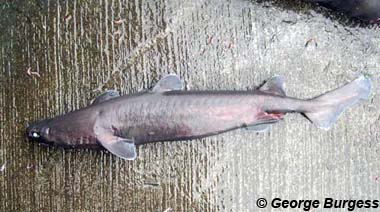
Dalatias licha
This blunt-faced shark has small, lobed fins and large eyes, best suited for its deep-water habitat. Normally it scavenges for small fish and crustaceans, but its top teeth are sharp and curve inward for grabbing, and its bottom teeth are straight and serrated for cutting, making it possible for this 3- to 4-foot shark to take big bites out of larger sharks and whales. Kitefins are caught by commercial fisheries for their oil-rich livers, flesh, and skin (which is used to make shagreen). Because of their small mouths and deep sea habitat, they are considered no threat to humans.
Order – Squaliformes
Family – Dalatiidae
Genus – Dalatias
Species – licha
Common Names
English language common names for Dalatias licha are kitefin shark, black shark, darkie charlie, and seal shark. Common names in other languages include cani monicu (Italian), carocho (Portuguese), chokladhaj (Swedish), chokoladehaj (Danish), diavolo (Italian), diavulu di funnu (Italian), gata (Portuguese), gata tramolla (Spanish), gata-lixa (Portuguese), gato (Portuguese), kalb (Arabic), lija (Spanish), lija negra (Spanish), liksa (Polish), murruna sewda (Maltese), naire (Italian), negra (Portuguese), neigra (Italian), paddottula (Italian), pailona (Portuguese), peixelim (Portuguese), peshkagen (Albanian), robhaai (Afrikaans), Schokoladenhai (German), simnus (Hebrew), skylopsaro (Greek), skymnoskylopsaro (Greek), squale liche (French), stire verde (Italian), trabolha (Portuguese), valse doornhaai (Dutch), yoroizame (Japanese), zegrine (Italian), zegrino (Italian), zegrino negro (Italian), and zwarte haai (Dutch).
Importance to Humans
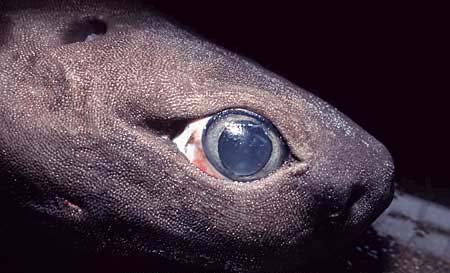
Kitefin sharks are of no importance in the western Atlantic Ocean, but sought for its squalene-rich liver oil and flesh in Japan, for its oil in South Africa, and for reduction into fishmeal in the eastern Atlantic Ocean.
Danger to Humans
The kitefin shark poses no danger to humans due to its small size and deepwater habitat.
Conservation
Primarily a bycatch species taken by trawl and hook, the kitefin shark is targeted in limited regions for its flesh and oil. Over the past few years, catches in Australia have been increasing in the last few years with the relaxation of mercury regulations and fishers searching for non-quota species in the South East Trawl Fishery. Data on biomass and trends in abundance are lacking, however the productivity of this species is likely to be low.
> Check the status of the kitefin shark at the IUCN website.
The IUCN is a global union of states, governmental agencies, and non-governmental organizations in a partnership that assesses the conservation status of species.
Geographical Distribution
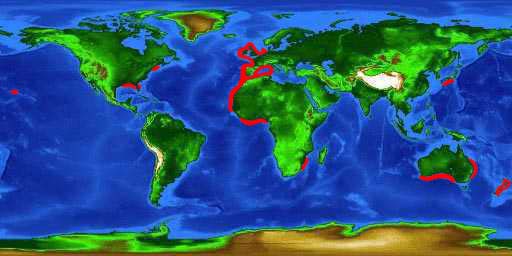
The distribution of the kitefin shark ranges from Georges Bank, the east coast of Florida, northern Gulf of Mexico, and off the southern Bahamas in the western Atlantic Ocean. In the eastern Atlantic Ocean, this shark is found from the North Sea southward to Cameroon, including the western Mediterranean Sea. It is also found in the central and western Pacific Ocean and the southwestern Indian Ocean.
Habitat
This shark is a solitary, epibenthic species found in tropical and warm-temperate regions. They are most commonly found in the deepest shelf and upper slope waters, usually at depths of 656-1,970 feet (200-600 m), but have been taken from depths of 121-5,900 feet (37-1,800 m). It hovers above the seabed, swimming well off the bottom.
Biology
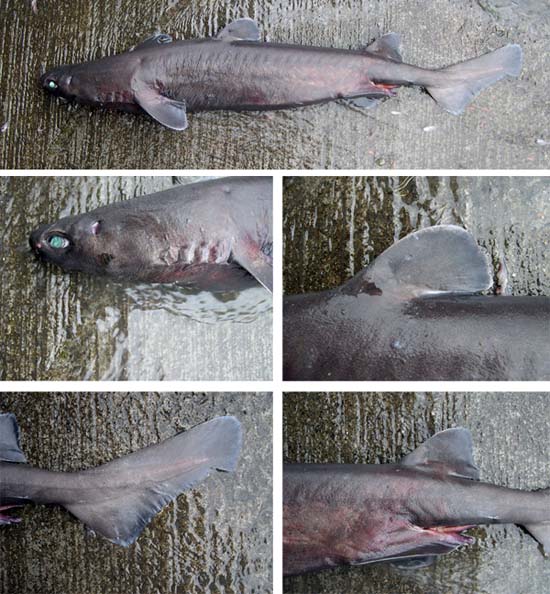
Distinctive Features
The kitefin shark is moderately sized with a short, conical, and blunt snout. The gill openings are short and the mouth is mildly arched with thick lips. The first dorsal fin originates just behind the rear tips of the short rounded pectoral fins. The dorsal fin base is closer to the pectoral fins than the pelvic fin bases. The second dorsal fin is slightly larger than the first, originating posteriorly on the body, over the midpelvic bases. The large upper caudal lobe has a well-developed subterminal notch with an essentially nonexistent lower lobe. There is no anal fin, lateral keels, or precaudal pits on the kitefin shark.
Sometimes confused with the Portuguese shark (Centroscymnus coelolepis), the kitefin appears similar to this species due to the sizes and positions of the fins and denticles. However, the dorsal fins of the kitefin shark lack spines. The Greenland shark (Somniosus microcephalus) is a much larger species and has a greatly expanded ventral lobe of the caudal fin and strongly oblique, smooth-edged lower teeth that form a cutting edge.
Coloration
Uniformly dark chocolate brown, grayish black, cinnamon, or violet brown in color, the kitefin shark often has poorly defined black spots on the dorsal surface. There is a lack of obvious black markings above the pelvic fins, ventrally on the caudal penduncle, or laterally on the upper caudal lobe. The fin margins are white or translucent, and the tail is tipped with black.
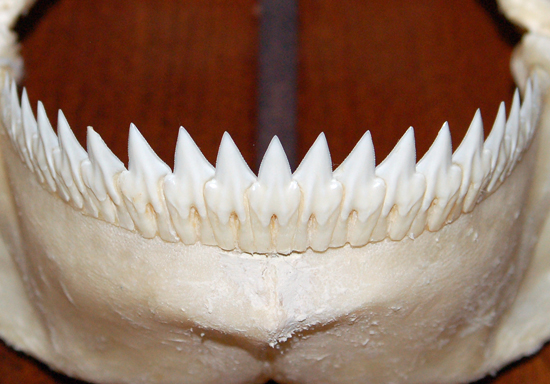
Dentition
The teeth of the kitefin shark are asymmetrical. The upper jaw contains 19 small teeth that are narrow, smooth, and awl-shaped, curving somewhat outward toward the corners of the mouth. The 19 teeth of the lower jaw are large with erect, broadly triangular, serrate cusps and overlapping bases.
Dermal Denticles
The dermal denticles are low and flattened with ridged, unicuspid crowns emerging from triangular bases.
Size, Age & Growth
Maximum size of the kitefin shark is 5.2 feet (1.59 m) (possibly to 6 feet (1.82 m)), however most of these sharks that are caught measure between 3.3-4.6 feet (1.0-1.4 m) in length. Mature males have been taken at lengths of 2.5-4 feet (0.77-1.21 m) and mature females have measured 3.8-5.2 feet (1.17-1.59 m).
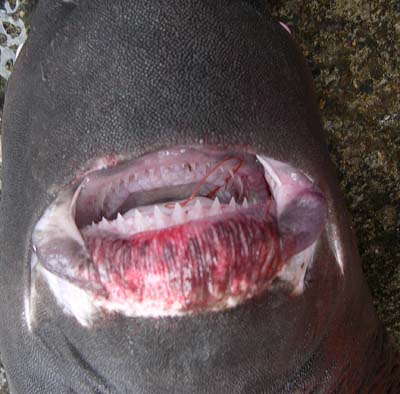
Food Habits
Kitefin sharks are formidable solitary predators with large, serrate teeth and powerful jaws. They consume a variety of small deepwater fishes, skates, and sharks; squids and octopods; shrimps and lobsters; isopods and amphipods; siphonophores; and polychaetes. Fishes make up the majority of their diet.
Reproduction
Reproduction of the kitefin shark takes place via ovoviviparity. A total of 10-16 young are born with each measuring about 12 inches (30 cm) in length.
Predators
Potential predators include large fish and sharks residing in the same habitats and depths as the kitefin shark.
Parasites
There are no available detailed studies on parasites of the kitefin shark.
Taxonomy
The kitefin shark was first described as Squalus licha by Bonnaterre in 1788. This name was later changed to Dalatias licha (Bonnaterre 1788). Synonyms used to refer to this species in past scientific literature include Squalus americanusGmelin 1789, Squalus nicaeensis Risso 1810, Scymnus vulgaris Cloquet 1822, Squalus scymnus Voigt 1832, Scymnorhinus phillippsi Whitley 1931, Pseudoscymnus boshuensis Herre 1935, Scymnorhinus brevipinnis Smith 1936, and Dalatias tachiensis Shen & Ting 1972.
Prepared by: Cathy Bester and George Burgess